Development of Sustainable Home using Net Zero Energy
Develop a report on the development of a sustainable home with net zero energy, comparing it to the current home and discussing energy and emissions aspects.
38 Pages5180 Words483 Views
Added on 2023-06-04
About This Document
This report attempts to develop a sustainable home with net zero energy by constructing “Your House (YH)” and a “Redesigned Home (RH)” at the same location in Melbourne, Australia. Our main objective is to minimize carbon emission and energy consumption in our Redesigned House by selecting construction materials that have low carbon content such as wood.
Development of Sustainable Home using Net Zero Energy
Develop a report on the development of a sustainable home with net zero energy, comparing it to the current home and discussing energy and emissions aspects.
Added on 2023-06-04
ShareRelated Documents
Development of Sustainable Home using Net Zero Energy
DEVELOPMENT OF SUSTAINABLE HOME USING NET ZERO ENERGY
By (Name)
Course
Professor’s name
University name
City, State
Date of submission
1 | P a g e
DEVELOPMENT OF SUSTAINABLE HOME USING NET ZERO ENERGY
By (Name)
Course
Professor’s name
University name
City, State
Date of submission
1 | P a g e
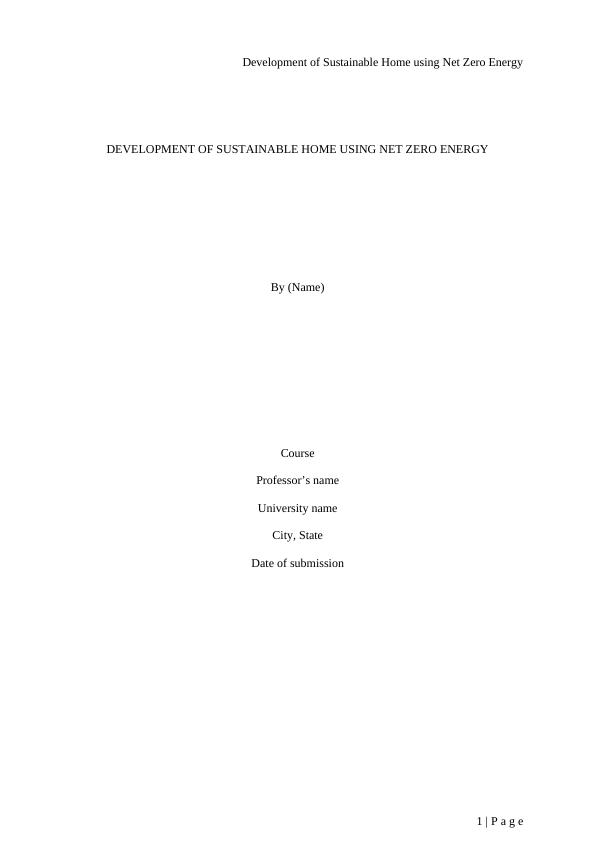
Development of Sustainable Home using Net Zero Energy
Abstract
This report attempts to develop a sustainable home with net zero energy by constructing
“Your House (YH)” and a “Redesigned Home (RH)” at the same location in Melbourne,
Australia. Our main objective is to minimize carbon emission and energy consumption in our
Redesigned House by selecting construction materials that have low carbon content such as
wood. All these analysis will be done using energy plus software and comparing the results of
both homes in regard to their carbon emission over a period of time, energy consumption,
appliances, and heating and cooling system used in both homes. Data generated from energy
plus is loaded into Homer pro software to help us identify the on-site renewable energy that
will enable us achieve a net zero energy home in our redesigned house. The simulation run in
HOMER software help in calculating the payback period on the capital spent in installing the
renewable sources of energy. The Redesigned House goes through a lifecycle processes
which include operation and maintenance (O&M) and waste generation has been analyzed in
the report to achieve a net zero energy building.
2 | P a g e
Abstract
This report attempts to develop a sustainable home with net zero energy by constructing
“Your House (YH)” and a “Redesigned Home (RH)” at the same location in Melbourne,
Australia. Our main objective is to minimize carbon emission and energy consumption in our
Redesigned House by selecting construction materials that have low carbon content such as
wood. All these analysis will be done using energy plus software and comparing the results of
both homes in regard to their carbon emission over a period of time, energy consumption,
appliances, and heating and cooling system used in both homes. Data generated from energy
plus is loaded into Homer pro software to help us identify the on-site renewable energy that
will enable us achieve a net zero energy home in our redesigned house. The simulation run in
HOMER software help in calculating the payback period on the capital spent in installing the
renewable sources of energy. The Redesigned House goes through a lifecycle processes
which include operation and maintenance (O&M) and waste generation has been analyzed in
the report to achieve a net zero energy building.
2 | P a g e
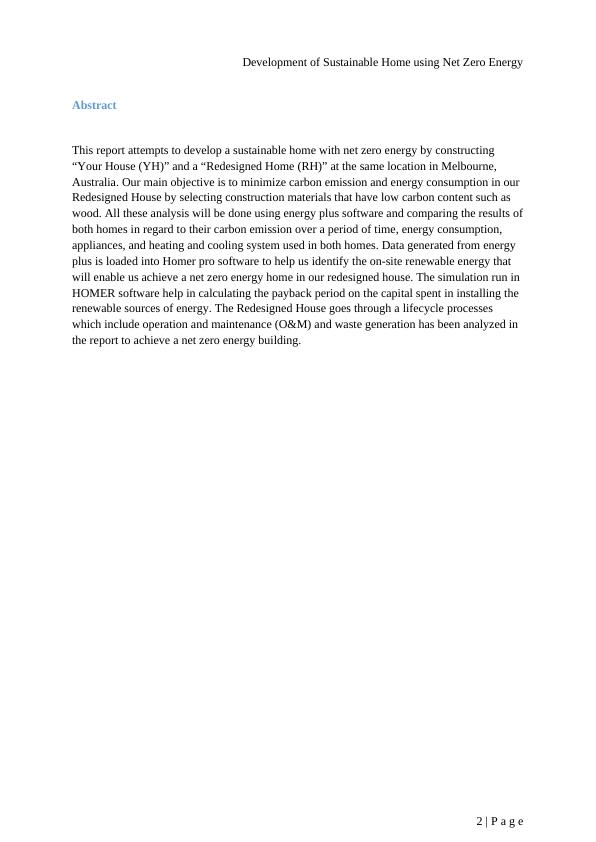
Development of Sustainable Home using Net Zero Energy
Contents
Abstract......................................................................................................................................1
Introduction..............................................................................................................................3
2.1 Review low/zero carbon design technology......................................................................5
Selection of low carbon construction materials......................................................................5
Innovative Construction Process............................................................................................8
Renewable Energy................................................................................................................14
2.2 YH Details.........................................................................................................................20
YH detail construction material............................................................................................21
Detail Construction Process for YH.....................................................................................22
Details of YH heating/cooling, hot water, and appliances...................................................23
2.3 RH Details.........................................................................................................................24
Selection of construction materials.......................................................................................24
Your Selection of manufacturing constituents for RH that need less
replacement/maintenance over their service life..................................................................27
Your selection of construction process that has fewer carbon emissions for RH.................29
Your approach to reuse and recycle construction materials for RH.....................................29
Your Energy management design to reduce energy consumption for heating/cooling........30
Your energy management design to reduce energy consumption for hot water, and
Appliances............................................................................................................................31
Your selection of on-site renewable energy.........................................................................32
2.4 Estimating the annual and total carbon emission over the service life of YH and RH
..................................................................................................................................................35
Estimation of embodied carbon emission of YH and RH Construction Material................35
Estimation of carbon emission related to the construction of YH and RH...........................37
Estimation of carbon emission related to maintenance........................................................38
Estimation of carbon emission from wastes of your rebuilt/redesigned home.....................40
Estimation of operating carbon emission in relation to the daily usage for hot water, and all
appliances of YH and RH.....................................................................................................41
Estimation of operating carbon emission in relation to the daily usage for heating and
cooling of YH and RH..........................................................................................................43
2.5 Use HOMER to design on-site renewable energy supply to achieve ‘net-zero-
emission’ over the service life of RH (e.g. 40 years)............................................................46
Released Carbon Dioxide Benefits.......................................................................................61
2.6 Estimate cost and benefit (e.g. energy saving) of RH in comparison with YH...........62
2.7 Discuss the feasibility and challenges of implementing RH, and the Ways to
overcome the challenges........................................................................................................63
References...............................................................................................................................65
3 | P a g e
Contents
Abstract......................................................................................................................................1
Introduction..............................................................................................................................3
2.1 Review low/zero carbon design technology......................................................................5
Selection of low carbon construction materials......................................................................5
Innovative Construction Process............................................................................................8
Renewable Energy................................................................................................................14
2.2 YH Details.........................................................................................................................20
YH detail construction material............................................................................................21
Detail Construction Process for YH.....................................................................................22
Details of YH heating/cooling, hot water, and appliances...................................................23
2.3 RH Details.........................................................................................................................24
Selection of construction materials.......................................................................................24
Your Selection of manufacturing constituents for RH that need less
replacement/maintenance over their service life..................................................................27
Your selection of construction process that has fewer carbon emissions for RH.................29
Your approach to reuse and recycle construction materials for RH.....................................29
Your Energy management design to reduce energy consumption for heating/cooling........30
Your energy management design to reduce energy consumption for hot water, and
Appliances............................................................................................................................31
Your selection of on-site renewable energy.........................................................................32
2.4 Estimating the annual and total carbon emission over the service life of YH and RH
..................................................................................................................................................35
Estimation of embodied carbon emission of YH and RH Construction Material................35
Estimation of carbon emission related to the construction of YH and RH...........................37
Estimation of carbon emission related to maintenance........................................................38
Estimation of carbon emission from wastes of your rebuilt/redesigned home.....................40
Estimation of operating carbon emission in relation to the daily usage for hot water, and all
appliances of YH and RH.....................................................................................................41
Estimation of operating carbon emission in relation to the daily usage for heating and
cooling of YH and RH..........................................................................................................43
2.5 Use HOMER to design on-site renewable energy supply to achieve ‘net-zero-
emission’ over the service life of RH (e.g. 40 years)............................................................46
Released Carbon Dioxide Benefits.......................................................................................61
2.6 Estimate cost and benefit (e.g. energy saving) of RH in comparison with YH...........62
2.7 Discuss the feasibility and challenges of implementing RH, and the Ways to
overcome the challenges........................................................................................................63
References...............................................................................................................................65
3 | P a g e

Development of Sustainable Home using Net Zero Energy
Introduction
There are buildings that consume energy from the grid while producing enough to sustain
itself from renewable energy sources. These buildings are referred to as “Net zero Energy
Buildings.” Many countries around the globe are chasing after the adoption of energy
policies that are formulated to achieve net zero energy. The definition of zero energy
building can be looked at in many ways that are dependent on political policies and the
goals set by the specific country. The approach taken in the definition of energy building
surrounds the framework for its definition and choice of the available options that could be
related.
Buildings that are used for processing work or where a processing industry is based and
have electrical appliances that consume electricity yet with zero carbon emissions are
referred to as zero energy/carbon buildings (Abrahamse, 2005).
The aim of this report is to explain the impact of climate change by having two buildings
with different material selection; one named YH and the other one is RH. This will help us
calculate the embodied carbon energy produced by both the houses and the cost of saving
determined when we use renewable sources of energy (Van den Bergh, 2008). The report
will conclude by giving the possibility of constructing a net zero energy building and the
challenges faced during this process.
2.1 Review low/zero carbon design technology
Selection of low carbon construction materials
This will involve simulation of two house model; one made of materials with high carbon
content and the second model being an improved version of YH, which will be constructed
using materials with low carbon content. Below is a graph showing the percentage of
embodied carbon of construction materials.
In most cases, low carbon materials can always be recycled which helps in reducing the
amount of embodied carbon. Manufactures have developed alternative low carbon materials
4 | P a g e
Introduction
There are buildings that consume energy from the grid while producing enough to sustain
itself from renewable energy sources. These buildings are referred to as “Net zero Energy
Buildings.” Many countries around the globe are chasing after the adoption of energy
policies that are formulated to achieve net zero energy. The definition of zero energy
building can be looked at in many ways that are dependent on political policies and the
goals set by the specific country. The approach taken in the definition of energy building
surrounds the framework for its definition and choice of the available options that could be
related.
Buildings that are used for processing work or where a processing industry is based and
have electrical appliances that consume electricity yet with zero carbon emissions are
referred to as zero energy/carbon buildings (Abrahamse, 2005).
The aim of this report is to explain the impact of climate change by having two buildings
with different material selection; one named YH and the other one is RH. This will help us
calculate the embodied carbon energy produced by both the houses and the cost of saving
determined when we use renewable sources of energy (Van den Bergh, 2008). The report
will conclude by giving the possibility of constructing a net zero energy building and the
challenges faced during this process.
2.1 Review low/zero carbon design technology
Selection of low carbon construction materials
This will involve simulation of two house model; one made of materials with high carbon
content and the second model being an improved version of YH, which will be constructed
using materials with low carbon content. Below is a graph showing the percentage of
embodied carbon of construction materials.
In most cases, low carbon materials can always be recycled which helps in reducing the
amount of embodied carbon. Manufactures have developed alternative low carbon materials
4 | P a g e
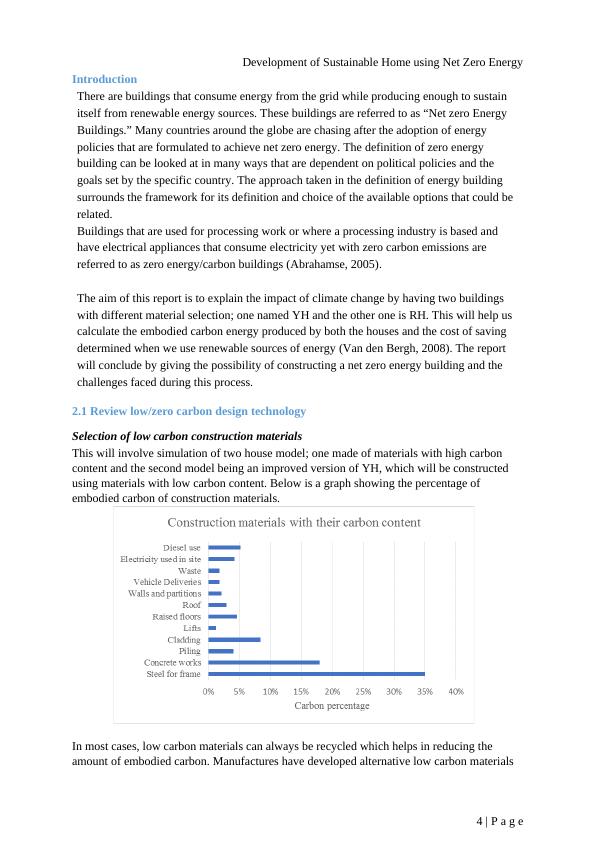
Development of Sustainable Home using Net Zero Energy
that can be used in construction. This materials include autoclaved aerated concrete,
recycled metal, compacted fly ash blocks, insulating concrete forms etc.
Innovative Construction Process
Building materials required to carry out any construction work, like cement and steel, should
be taken through a number of processes before they are delivered on site for use. Energy is
consumed in all the processes that are undertaken in the production and delivery of the
materials and can be calculated based on carbon emissions (Khan et al. 2004). The carbon
emissions equivalent of the energy used by the different processes can then be expressed as
carbon embodied in that structure. Therefore, to achieve a net zero building, the materials
selected by the designer have to be of least embodied emissions. Another factor that has to
be considered by the designer is that the selected materials need to be recyclable.
Renewable Energy Sources
Renewable energy comes from a source that naturally and sustainably replaces itself, such as
solar energy or geothermal. Some of the sources that are common include;
Solar Energy
Solar energy is produced through a photovoltaic effect that involves reception of sun rays by
the photovoltaic cells and converting into electricity. Installation of the solar panel is mostly
done on roofs specifically for reception of maximum sunlight (Martchek, 2000).
Technologies that apply the solar energy are;
Photovoltaic systems
Hot water systems
Electricity from solar
Passive solar heating and daylighting
Solar process space heating and cooling
Wind Energy
Energy from wind has been relied upon for a long time. Windmills have been used locally for
water pumping as well as grinding grains. The wind mill has in the recent age found
application in electricity generation as well. The height of wind turbines is usually around 30
m and use propellers to pick up wind speed and start revolving (Lewis, 2007). The propeller
connected to a turbine generator transfers the rotating motion to the turbine thus producing
electrical energy through electromagnetic effect. The wind turbine can be standalone or
networked with others to achieve a higher power generation.
Before installation of wind turbine in a new location, weather data that were previously
collected need to be inspected so as to determine the speed of wind for the location. This is to
determine the suitability of the location for the installation.
Geothermal Energy
This is energy from under the ground usually from hot rocks or hot water that generates
steam used to drive steam turbines. The energy can also be sourced from magma that is found
underground (Steg, 2008). The thermal energy finds application in electricity generation and
heating or cooling of buildings.
5 | P a g e
that can be used in construction. This materials include autoclaved aerated concrete,
recycled metal, compacted fly ash blocks, insulating concrete forms etc.
Innovative Construction Process
Building materials required to carry out any construction work, like cement and steel, should
be taken through a number of processes before they are delivered on site for use. Energy is
consumed in all the processes that are undertaken in the production and delivery of the
materials and can be calculated based on carbon emissions (Khan et al. 2004). The carbon
emissions equivalent of the energy used by the different processes can then be expressed as
carbon embodied in that structure. Therefore, to achieve a net zero building, the materials
selected by the designer have to be of least embodied emissions. Another factor that has to
be considered by the designer is that the selected materials need to be recyclable.
Renewable Energy Sources
Renewable energy comes from a source that naturally and sustainably replaces itself, such as
solar energy or geothermal. Some of the sources that are common include;
Solar Energy
Solar energy is produced through a photovoltaic effect that involves reception of sun rays by
the photovoltaic cells and converting into electricity. Installation of the solar panel is mostly
done on roofs specifically for reception of maximum sunlight (Martchek, 2000).
Technologies that apply the solar energy are;
Photovoltaic systems
Hot water systems
Electricity from solar
Passive solar heating and daylighting
Solar process space heating and cooling
Wind Energy
Energy from wind has been relied upon for a long time. Windmills have been used locally for
water pumping as well as grinding grains. The wind mill has in the recent age found
application in electricity generation as well. The height of wind turbines is usually around 30
m and use propellers to pick up wind speed and start revolving (Lewis, 2007). The propeller
connected to a turbine generator transfers the rotating motion to the turbine thus producing
electrical energy through electromagnetic effect. The wind turbine can be standalone or
networked with others to achieve a higher power generation.
Before installation of wind turbine in a new location, weather data that were previously
collected need to be inspected so as to determine the speed of wind for the location. This is to
determine the suitability of the location for the installation.
Geothermal Energy
This is energy from under the ground usually from hot rocks or hot water that generates
steam used to drive steam turbines. The energy can also be sourced from magma that is found
underground (Steg, 2008). The thermal energy finds application in electricity generation and
heating or cooling of buildings.
5 | P a g e

Development of Sustainable Home using Net Zero Energy
Hydropower
Hydropower is the most common type of renewable energy sourced from water pressure. A
large dam is used to store the water which is directed to a turbine under pressure making it to
rotate and then convert the mechanical energy to electrical energy (Goswami 2004).
Bio-energy
Bio-energy comes from biomass which is a natural matter constituting plants and animals.
Biomass products include chemicals, power and transportation fills. It can also be
transformed into fossil fuel when it remains on the earth’s surface for many years. The
process of photosynthesis allows chlorophyll in plants to catch solar energy and fetch carbon
dioxide from the atmosphere and water beginning from the early stage starch (Dixit et al.
2010). When the sugars are smoldered, they convert to carbon dioxide and water and release
the energy received from the sun.
Ocean Energy
There are three categories under ocean energy;
Energy from waves, which is generated ocean waves on the shores.
Tidal energy, as a result of the rise and fall in the tides.
Ocean thermal energy, due to temperature difference in the ocean.
Recycle and Reuse
Proper utilization of natural resources can be achieved through recycling. The use of water
and energy can be reduced, contamination limited and temperature modification decreased by
excluding the development, conveyance and removal of new products (Borenstein 2008).
Recycling and reusing has been promoted recently by the Australian government in its
completion of the study on construction status and demolition.
6 | P a g e
Hydropower
Hydropower is the most common type of renewable energy sourced from water pressure. A
large dam is used to store the water which is directed to a turbine under pressure making it to
rotate and then convert the mechanical energy to electrical energy (Goswami 2004).
Bio-energy
Bio-energy comes from biomass which is a natural matter constituting plants and animals.
Biomass products include chemicals, power and transportation fills. It can also be
transformed into fossil fuel when it remains on the earth’s surface for many years. The
process of photosynthesis allows chlorophyll in plants to catch solar energy and fetch carbon
dioxide from the atmosphere and water beginning from the early stage starch (Dixit et al.
2010). When the sugars are smoldered, they convert to carbon dioxide and water and release
the energy received from the sun.
Ocean Energy
There are three categories under ocean energy;
Energy from waves, which is generated ocean waves on the shores.
Tidal energy, as a result of the rise and fall in the tides.
Ocean thermal energy, due to temperature difference in the ocean.
Recycle and Reuse
Proper utilization of natural resources can be achieved through recycling. The use of water
and energy can be reduced, contamination limited and temperature modification decreased by
excluding the development, conveyance and removal of new products (Borenstein 2008).
Recycling and reusing has been promoted recently by the Australian government in its
completion of the study on construction status and demolition.
6 | P a g e
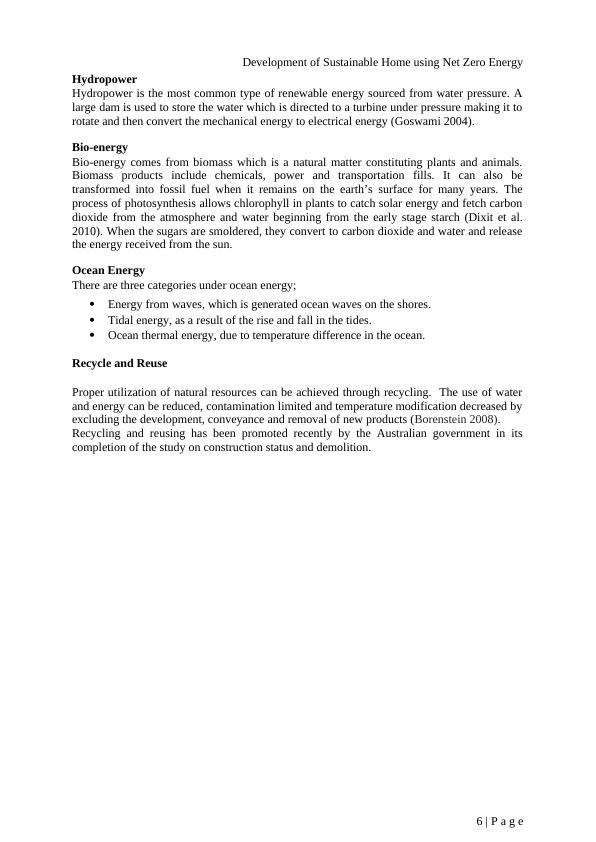
Development of Sustainable Home using Net Zero Energy
2.2 YH Details
The house model used for this analysis is sample house 1. The design is located in
Hawthorn, in the suburb areas of Melbourne. The house plan as shown above
accommodate spaces such as family room, dining, master bedroom ensuite, 2 bedroom,
bathroom, corridor and a garage. The house covers an area of 214.157m2.
7 | P a g e
2.2 YH Details
The house model used for this analysis is sample house 1. The design is located in
Hawthorn, in the suburb areas of Melbourne. The house plan as shown above
accommodate spaces such as family room, dining, master bedroom ensuite, 2 bedroom,
bathroom, corridor and a garage. The house covers an area of 214.157m2.
7 | P a g e
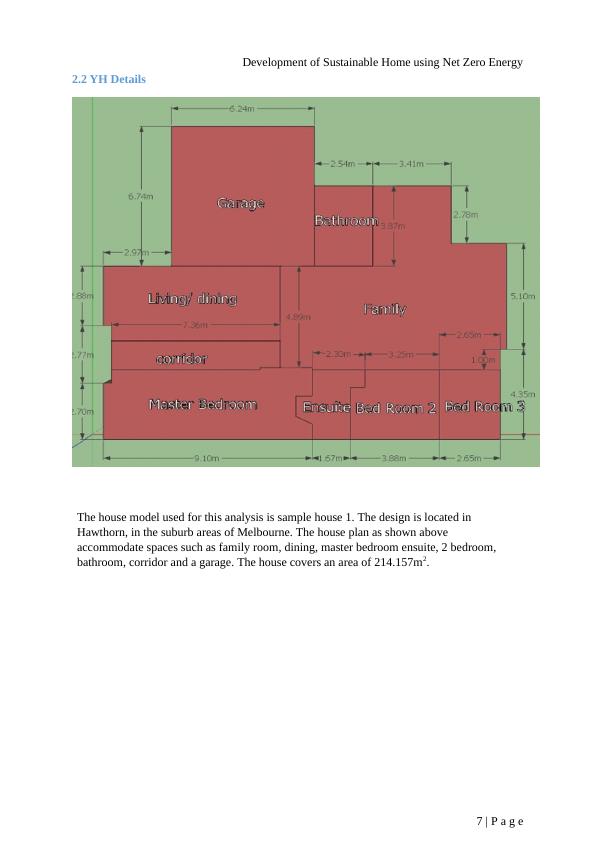
Development of Sustainable Home using Net Zero Energy
Isometric Views
YH detail construction material
Selection of materials used in the construction of YH include wall insulation, ceiling
insulation, ceiling plasterboard, wall plasterboard, concrete slab, carpet, ceramic floor in
the wet areas, door material.
This materials were defined in the Energy plus (EP) software as shown below:
8 | P a g e
Isometric Views
YH detail construction material
Selection of materials used in the construction of YH include wall insulation, ceiling
insulation, ceiling plasterboard, wall plasterboard, concrete slab, carpet, ceramic floor in
the wet areas, door material.
This materials were defined in the Energy plus (EP) software as shown below:
8 | P a g e

End of preview
Want to access all the pages? Upload your documents or become a member.
Related Documents
Development of Sustainable Home using Net Zero Energylg...
|28
|2719
|339
New Methods of Technology for Zero Net Energy Buildingslg...
|70
|14296
|67
Development of Sustainable Home Using Net Zero Energylg...
|42
|7673
|451
Development of Sustainable Home using Net Zero Energylg...
|34
|4131
|71
Low Carbon Building Design: Approaches, Embodied Energy and Carbon Calculation, and Comparison with Original Modellg...
|17
|1972
|186
Creating and Building Sustainable Homes for Environmental Sustainabilitylg...
|8
|1340
|487
